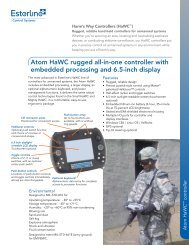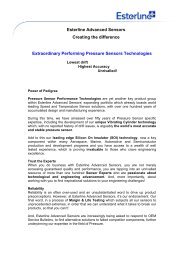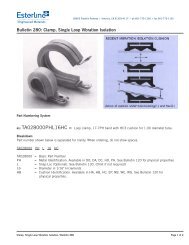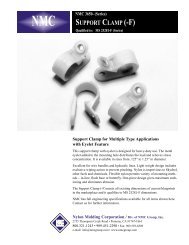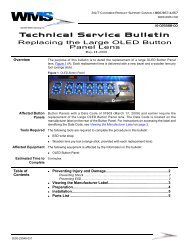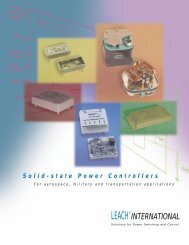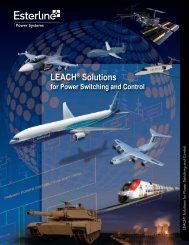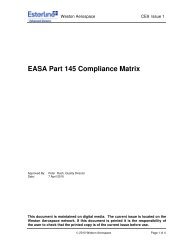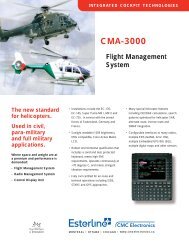You also want an ePaper? Increase the reach of your titles
YUMPU automatically turns print PDFs into web optimized ePapers that Google loves.
Page 3 of 4This device is intended to limit the duration of fast occurringdamage, typically due to an arc, which is below the instanttrip and before the I 2 t trip levels as shown in Fig. 3.2) Logical comparison of signals to ensure a stable signalsource.3) Setting of level related thresholds.10000.060A ELCU Trip Curve4) Setting of time related thresholds.Instant Trip Region5) Coil disconnection when a fast fault is detected.1000.0Current(Amps rms)I 2 t Maximum Trip Limit6) Latching the fault detected condition until powerremoved.100.0Fast Trip RegionI 2 t Minimum Trip10.00.01 0.1 1 10 100 1000 10000Trip Time (seconds)Figure 3.B. Physical RequirementsThe physical requirements include form; fit and function toenable direct replacement of existing products.The available space envelope for some applications may beable to be increased but the mounting footprint is maintainedthe same as the unprotected device to provide a directreplacement.There is also a weight increase of 5% due to the addedcomponents and increase in height.C. Physical ImplementationA minimal increase in overall volume was required for themodule be fully integrated and connected into the basicassembly.A single layer PCB is used to hold all additional components.The prototype has an external physical difference of anincrease of 1.0 inches in height, which may be seen as ahousing extension in Fig.4.The circuit may be integrated within the existing envelope.D. Circuit DescriptionFig.2 is a block diagram of the model ZE ELCU contactorwith the addition of the <strong>Arc</strong> Detecting, or fast trip, modulecircuitry.Existing circuit functions are employed with the addition oflogic, filtering and integration functions.The major functions of the circuit of Fig.2 are:-1) Filtering of the incoming signals to remove noise.A. TestsFigure 4.IV. PERFORMANCEThe <strong>Arc</strong> Detecting ELCU was tested with both a manuallyoperated chaotic arc generator and an electronicallycontrolled arc generator. The electronically controlled highcurrent arc generator was designed to provide the equivalentof repeatable but programmable arc faults with timingconsistent with testing proposed for lower level single-phasearc detecting devices. The ELCU was also tested on arepresentative aircraft power panel, in a power systemlaboratory, with a representative system load.B. Test Results1) The ELCU tripped to arc faults induced using a manualarc fault generator, both in the laboratory and in the powerpanel configuration. Typical individual arc waveformssuperimposed on the load current are shown in Figs. 6 and 7.2) The ELCU tripped to varying configurations of partialsine arc fault where each fault configuration provided greaterthan the minimum setting levels within the preset timeperiods.




